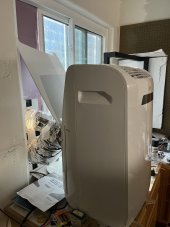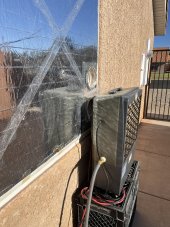copec
Solar Enthusiast
- Joined
- Jan 23, 2021
- Messages
- 335
I have a couple of twin hose portable AC/Heat Pump units. I live about 90 minutes East of Vegas. It’s not like this isn’t a common thing with large facilities compounding evaporative cooling towers with refrigeration cycles, but I thought I would experiment a little with the unit in my garage by pointing a portable evaporative cooler into the intake of the portable AC unit and measure power and temperatures.
At 6:30PM today the intake temperature was ~100F, with the outlet being ~145F, and the unit taking ~1.1kw. Indoors the intake temp is ~77F and the outlet is ~42F.
After turning on the evap cooler and waiting about 10 minutes for the temperatures to stabilize, the outdoor intake was ~71F, with the outlet ~135F. Indoors the intake was ~76F with the outlet ~31F, the power usage dropped to ~900W as well. The evap cooler on low takes ~80W.
So hugely beneficial with my 8% relative humidity right now. I don’t know exactly know how much water the evap cooler consumes, although I converted my yard to xeriscape a couples of years ago, so all-in-all I’m consuming a fraction of the water I used to anyways.
At 6:30PM today the intake temperature was ~100F, with the outlet being ~145F, and the unit taking ~1.1kw. Indoors the intake temp is ~77F and the outlet is ~42F.
After turning on the evap cooler and waiting about 10 minutes for the temperatures to stabilize, the outdoor intake was ~71F, with the outlet ~135F. Indoors the intake was ~76F with the outlet ~31F, the power usage dropped to ~900W as well. The evap cooler on low takes ~80W.
So hugely beneficial with my 8% relative humidity right now. I don’t know exactly know how much water the evap cooler consumes, although I converted my yard to xeriscape a couples of years ago, so all-in-all I’m consuming a fraction of the water I used to anyways.




